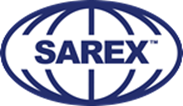
Oil Sludge Semi-Solids & Solids

Oily sludge feed is accepted in roll off bins (and other accepted containers) and will be dumped into an approved receiving bin and fed into the MX2000 feed hopper. The feed hopper will have covers that can be closed when material is not being transferred. The wet sludge will be transferred from the MX2000 feed hopper via an enclosed drag flight conveyer to the MX2000 thermal desorption unit. The material will be heated to approximately 250 degrees Fahrenheit by a non-contacting steam heated thermal desorption dryer to remove any water and light end oil vapors.
The vapors will be routed under negative pressure to the SAREX® Vapor Recovery System (VRS) where they will be condensed with a series of wet scrubbers, de-misters, and an air chiller. The discharged air will be polished with a dual stage 1000 Lb. granulated activated carbon (GAC) packs, which will be recycled to the manufacturer when spent. The scrubber water and condensed light end oil vapors will be pumped to an oil/water separator (OWS).

The condensed oil form the scrubber water will be separated with the secondary oil water separator (OWS) and will be pumped to the MX1500 feed tank where it will be mixed with other compatible MX1500 feed streams to be processed and collected as recovered oil product. The collected water from the secondary OWS will be pumped to the receiver tank(s) where it will be monitored for discharge by specified parameters. Dry solids discharged by the MX2000 will be collected in roll-off bins and dump trailers for recycling as a landfill cover or landfilled as industrial solids. The solids in most cases will be a dry powder that contains less than 10% moisture by weight giving it an appearance similar to top soil.


